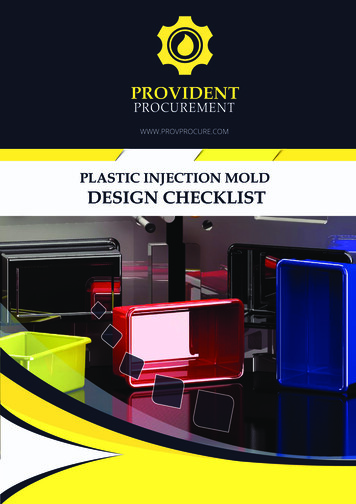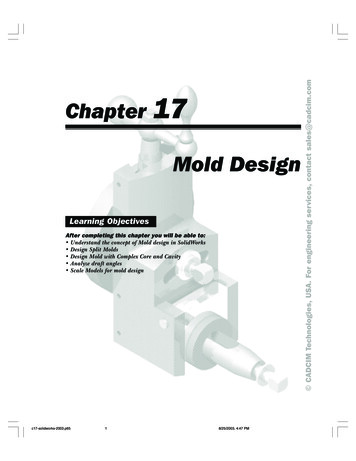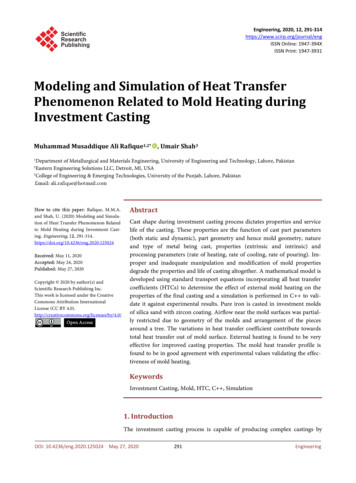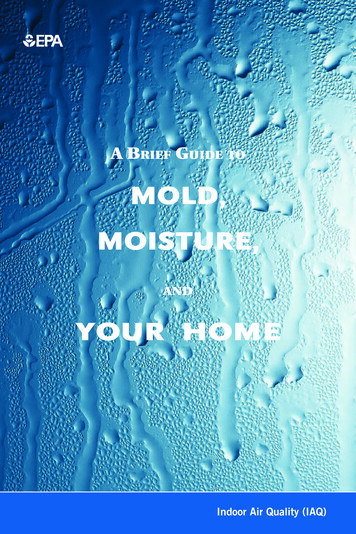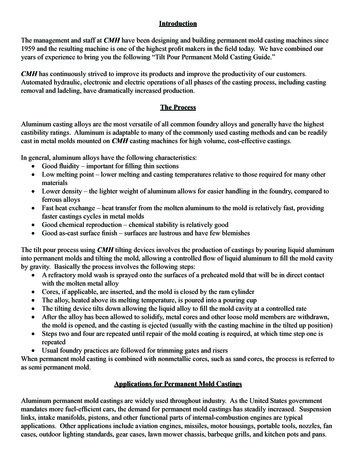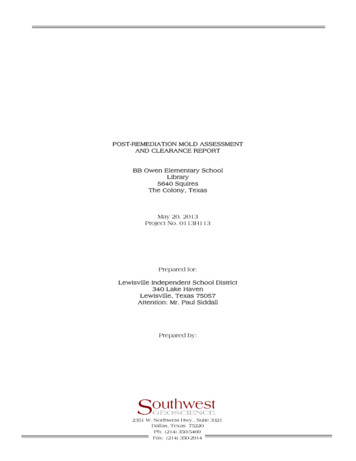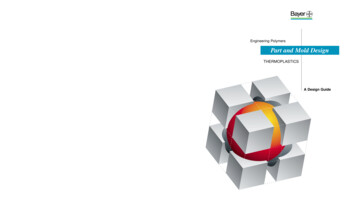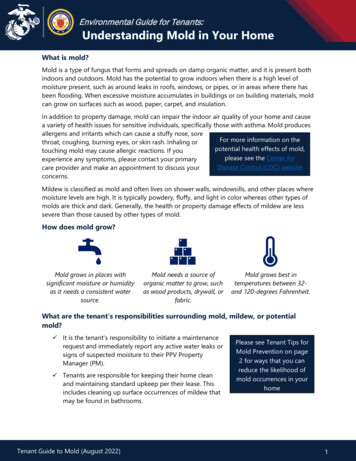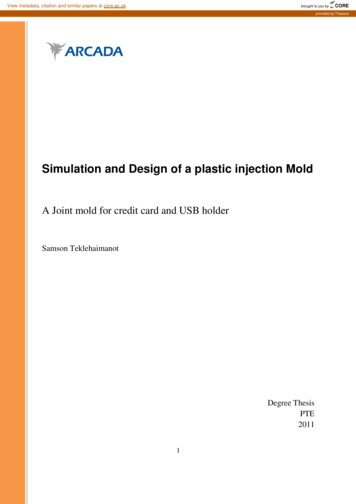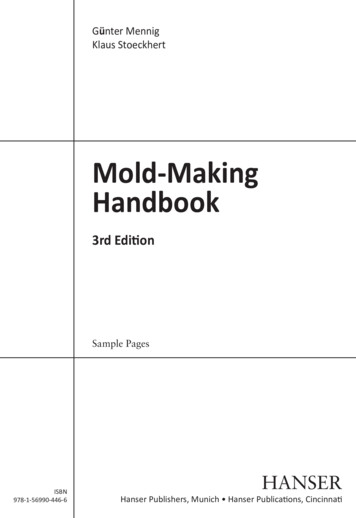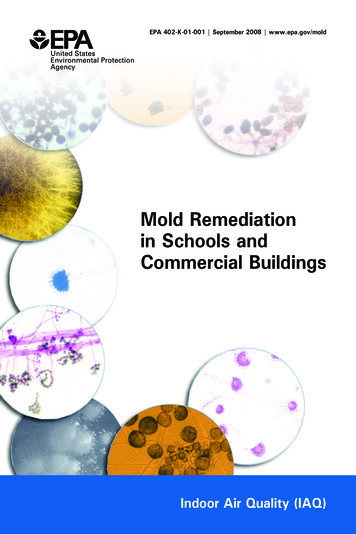
Transcription
Mold Remediation in Schools and Commercial BuildingsAcknowledgementsThis document was prepared by the Indoor Environments Division(IED) of the U.S. Environmental Protection Agency. IED would like to thankthe reviewers of this document who provided many valuable and insightfulcomments, and the contractors who provided support during thedevelopment of this document. EPA would also like to thank those whoprovided photos: Terry Brennan (Photo #2, Photo #3A, Photo #4A, Photo#6, Photo #8, Photo #9); Paul Ellringer (Photo #4C); Stephen Vesper, Ph.D.(Photo #3B); and Chin Yang, Ph.D. (cover photos, Photo #4B, Photo #5,Photo #7).Please note that this document presents recommendations on moldremediation. EPA does not regulate mold or mold spores in indoor air.This document is available as a text-searchable HTML document on EPA’s webserver at:www.epa.gov/iaq/molds (last updated - June 25, 2001).You can download an Adobe Acrobat version of this document pdfintro-pages.p65207/02/2001, 10:37 AM
EPA 402-K-01-001March 2001Mold Remediationin Schools andCommercialBuildingsU.S. Environmental Protection AgencyOffice of Air and RadiationIndoor Environments Division1200 Pennsylvania Avenue, NWMailcode: 6609JWashington, DC 20460www.epa.gov/iaq/molds(last updated - June 25, 2001)Adobe Acrobat PDF .pdfintro-pages.p65107/02/2001, 10:37 AM
CONTENTSINTRODUCTION . 1PREVENTION . 3INVESTIGATING, EVALUATING, AND REMEDIATING MOISTURE ANDMOLD PROBLEMS . 4Mold Remediation – Key Steps .Plan the Remediation Before Starting Work .Remediation Plan .HVAC System .Hidden Mold .56678Remediation . 9Table 1: Water Damage – Cleanup and Mold Prevention . 10Table 2: Mold Remediation Guidelines . 12Cleanup Methods . 16Personal Protective Equipment (PPE) . 19Containment . 21Equipment . 23How Do You Know When You Have FinishedRemediation/Cleanup? . 26CHECKLIST FOR MOLD REMEDIATION . 27RESOURCES LIST . 29REFERENCES . 35APPENDIX A – GLOSSARY . 37APPENDIX B – INTRODUCTION TO MOLDS . 39Molds in the Environment .Health Effects and Symptoms Associated with Mold Exposure .Mold Toxins .Microbial Volatile Organic Compounds (mVOCs) .Glucans or Fungal Cell Wall Components .Spores .393941434343APPENDIX C – COMMUNICATION WITH BUILDING OCCUPANTS . 45Mold in Schools . 45INDEX . 47INSERT: CHECKLIST FOR MOLD REMEDIATIONintro-pages.p65303/29/2001, 7:44 AM
Moisture Control is the Key to Mold ControlINTRODUCTIONConcern about indoor exposure to mold has been increasing as thepublic becomes aware that exposure to mold can cause a variety ofhealth effects and symptoms, including allergic reactions. Thisdocument presents guidelines for the remediation/cleanup of moldand moisture problems in schools and commercial buildings; theseguidelines include measures designed to protect the health ofbuilding occupants and remediators. It has been designed primarilyfor building managers,custodians, and othersMolds gradually destroy the things theywho are responsible forgrow on. Prevent damage to buildingcommercial buildingmaterials and furnishings, save money,and schooland avoid potential health risks bymaintenance. It shouldcontrolling moisture and eliminating moldserve as a reference forgrowth.potential mold andmoisture remediators.Using this document,individuals with littleor no experience withmold remediationshould be able to makea reasonable judgmentas to whether thesituation can behandled in-house. Itwill help those inPhoto 2: Extensive mold contamination ofcharge of maintenanceceiling and wallsto evaluate an in-houseremediation plan or aremediation plan submitted by an outside contractor. 1 Contractorsand other professionals who respond to mold and moisture situationsin commercial buildings and schools may also want to refer to theseguidelines.1If you choose to use outside contractors or professionals, make sure they haveexperience cleaning up mold, check their references, and have them follow therecommendations presented in this document, the guidelines of the AmericanConference of Government Industrial Hygienists (ACGIH) (see Resources List),and/or guidelines from other professional organizations.1inside.p65106/12/2001, 10:08 AM
Mold Remediation in Schools and Commercial BuildingsMolds can be found almost anywhere; they can grow on virtuallyany organic substance, as long as moisture and oxygen are present.There are molds that can grow on wood, paper, carpet, foods, andinsulation. When excessive moisture accumulates in buildings or onbuilding materials, mold growth will often occur, particularly if themoisture problem remains undiscovered or unaddressed. It isimpossible to eliminate all mold and mold spores in the indoorenvironment. However, mold growth can be controlled indoors bycontrolling moisture indoors.Molds reproduce by making spores that usually cannot be seenwithout magnification. Mold spores waft through the indoor andoutdoor air continually. When mold spores land on a damp spotindoors, they may begin growing and digesting whatever they aregrowing on in order to survive. Molds gradually destroy the thingsthey grow on.Many types of molds exist. All molds have the potential to causehealth effects. Molds can produce allergens that can trigger allergicreactions or even asthma attacks in people allergic to mold. Others areknown to produce potent toxins and/or irritants. Potential healthconcerns are an important reason to prevent mold growth and toremediate/clean up any existing indoor mold growth.Since mold requires water to grow, it is important to prevent moistureproblems in buildings. Moisture problems can have many causes,including uncontrolled humidity. Some moisture problems inbuildings have been linked to changes in building constructionpractices during the 1970s, 80s, and 90s. Some of these changeshave resulted in buildings that are tightly sealed, but may lackadequate ventilation, potentially leading to moisture buildup.Building materials, such as drywall, may not allow moisture toescape easily. Moisture problems may include roof leaks,landscaping or gutters that direct water into or under the building,and unvented combustion appliances. Delayed maintenance orinsufficient maintenance are also associated with moisture problemsin schools and large buildings. Moisture problems in portableclassrooms and other temporary structures have frequently beenassociated with mold problems.2inside.p65203/29/2001, 7:41 AM
Moisture Control is the Key to Mold ControlWhen mold growth occurs in buildings, adverse health problemsmay be reported by some building occupants, particularly thosewith allergies or respiratory problems. Remediators should avoidexposing themselves and others to mold-laden dusts as they conducttheir cleanup activities. Caution should be used to prevent mold andmold spores from being dispersed throughout the air where theycan be inhaled by building occupants.PREVENTIONThe key to mold control is moisture control. Solve moistureproblems before they become mold problems!Mold Prevention Tips Fix leaky plumbing and leaks in the building envelope as soon aspossible. Watch for condensation and wet spots. Fix source(s) of moistureproblem(s) as soon as possible. Prevent moisture due to condensation by increasing surfacetemperature or reducing the moisture level in air (humidity). Toincrease surface temperature, insulate or increase air circulation.To reduce the moisture level in air, repair leaks, increaseventilation (if outside air is cold and dry), or dehumidify (if outdoorair is warm and humid). Keep heating, ventilation, and air conditioning (HVAC) drip pansclean, flowing properly, and unobstructed. Vent moisture-generating appliances, such as dryers, to theoutside where possible. Maintain low indoor humidity, below 60% relative humidity (RH),ideally 30-50%, if possible. Perform regular building/HVAC inspections and maintenance asscheduled. Clean and dry wet or damp spots within 48 hours. Don’t let foundations stay wet. Provide drainage and slope theground away from the foundation.3inside.p65303/29/2001, 7:41 AM
Mold Remediation – Key StepsConsult health professionalas appropriatethroughout processSelectremediation managerAssess size of mold problemand note type ofmold-damaged materialsCommunicate with buildingoccupants throughout processas appropriate to situationPlan remediation,adapt guidelines tofit situation, see Tables 1 & 2Select personal protectiveequipment (PPE)Hidden mold discovered,reevaluate planClean and drymoldy materialsSee Table 2Select containmentequipmentDiscard moldy itemsthat can’t be cleanedCheck for return ofmoisture and mold problemSelect remediationpersonnel or teamIn-houseexpertiseRemediateDry non-moldy itemswithin 48 hoursSee Table 1Identify source orcause of water ormoisture problemOutsideexpertiseFix water ormoisture problem
Mold Remediation in Schools and Commercial BuildingsINVESTIGATING, EVALUATING, AND REMEDIATINGMOISTURE AND MOLD PROBLEMSSafety Tips While Investigating and EvaluatingMold and Moisture Problems Do not touch mold or moldy items with bare hands.Do not get mold or mold spores in your eyes.Do not breathe in mold or mold spores.Consult Table 2 and text for Personal Protective Equipment (PPE)and containment guidelines. Consider using PPE when disturbing mold. The minimum PPE is an N-95respirator, gloves, and eye protection.Moldy Areas Encountered During an InvestigationPhoto 3A: Mold growing in closet asa result of condensation from roomairPhoto 3B: Front side of wallboard looks fine, but the backside is covered with mold4inside.p65403/29/2001, 7:41 AM
Mold Remediation in Schools and Commercial BuildingsPLAN THE REMEDIATION BEFORE STARTING WORKQuestions to Consider BeforeRemediating Are there existing moistureproblems in the building? Have building materials beenwet more than 48 hours? (SeeTable 2 and text) Are there hidden sources ofwater or is the humidity toohigh (high enough to causecondensation)? Are building occupantsreporting musty or moldyodors? Are building occupantsreporting health problems? Are building materials orfurnishings visibly damaged? Has maintenance beendelayed or the maintenanceplan been altered? Has the building been recentlyremodeled or has building usechanged? Is consultation with medical orhealth professionals indicated?Remediation PlanAssess the size of the mold and/or moisture problem and thetype of damaged materialsbefore planning the remediationwork. Select a remediationmanager for medium or largejobs (or small jobs requiringmore than one person). Theremediation plan should includesteps to fix the water or moistureproblem, or the problem mayreoccur. The plan should coverthe use of appropriate PersonalProtective Equipment (PPE) andinclude steps to carefullycontain and remove moldybuilding materials to avoidspreading the mold. 2 Aremediation plan may varygreatly depending on the sizeand complexity of the job, andmay require revision ifcircumstances change or newfacts are discovered.The remediation manager’shighest priority must be toprotect the health and safety of the building occupants andremediators. It is also important to communicate with buildingoccupants when mold problems are identified. 3 In some cases,2Molds are known allergens and may be toxic. You may wish to use PersonalProtective Equipment (PPE) while investigating a mold problem, as well as duringremediation/clean-up situations. The minimum PPE includes an N-95 respirator,gloves, and eye protection.3See Appendix C.6inside.p65606/25/2001, 11:02 AM
Moisture Control is the Key to Mold Controlespecially those involving large areas of contamination, theremediation plan may include temporary relocation of some or all ofthe building occupants. The decision to relocate occupants shouldconsider the size and type of the area affected by mold growth, thetype and extent of health effects reported by the occupants, thepotential health risks that could be associated with debris, and theamount of disruption likely to be caused by remediation activities. Ifpossible, remediation activities should be scheduled during off-hourswhen building occupants are less likely to be affected.Remediators, particularly those with health-related concerns, maywish to check with their doctors or health care professionals beforeworking on mold remediation or investigating potentially moldyareas. If you have any doubts or questions, you should consult ahealth professional before beginning a remediation project.HVAC SystemDo not run the HVAC system if you know or suspect that it iscontaminated with mold. If you suspect that it may be contaminated(it is part of an identified moisture problem, for instance, or there ismold growth near the intake to the system), consult EPA’s guideShould You Have the Air Ducts in Your Home Cleaned? 4 before takingfurther action (see Resources List).4C4A4BPhoto 4A: Contaminated fibrous insulationinside air handler cover4Photo 4B: Mold growthon air diffuser in ceilingPhoto 4C: Moldy air ductAlthough this document has a residential focus, it is applicable to other buildingtypes.7inside.p65703/29/2001, 7:41 AM
Mold Remediation in Schools and Commercial BuildingsHidden Mold GrowthHidden MoldIn some cases, indoormold growth may notbe obvious. It ispossible that mold maybe growing on hiddensurfaces, such as theback side of dry wall,wallpaper, or paneling,the top of ceiling tiles,the underside ofcarpets and pads, etc.Possible locations ofhidden mold canPhoto 5: Mold growth behind wallpaperinclude pipe chasesand utility tunnels (with leaking or condensing pipes), walls behindfurniture (where condensation forms), condensate drain pans insideair handling units, porous thermal or acoustic liners inside ductwork,or roof materials above ceiling tiles (due to roof leaks or insufficientinsulation). Some building materials, such as dry wall with vinylwallpaper over it or wood paneling, may act as vapor barriers, 5trapping moisture underneath their surfaces and thereby providing amoist environment where mold can grow. You may suspect hiddenmold if a building smells moldy, but you cannot see the source, or ifyou know there has been water damage and building occupants arereporting health problems. Investigating hidden mold problems maybe difficult and will require caution when the investigation involvesdisturbing potential sites of mold growth—make sure to use PPE. Forexample, removal of wallpaper can lead to a massive release of sporesfrom mold growing on the underside of the paper. If you believe thatyou may have a hidden mold problem, you may want to considerhiring an experienced professional. If you discover hidden mold, youshould revise your remediation plan to account for the total areaaffected by mold growth.5For more information on vapor barriers and building construction, see ResourcesList. It is important that building materials be able to dry; moisture should not betrapped between two vapor barriers or mold may result.8inside.p65803/29/2001, 7:41 AM
Moisture Control is the Key to Mold ControlREMEDIATION1. Fix the water or humidityproblem. Complete and carryout repair plan if appropriate.Revise and/or carry outmaintenance plan if necessary.Revise remediation plan asnecessary, if more damage isdiscovered during remediation.See Mold Remediation – KeySteps (page 5) and ResourcesList (page 29) for additionalinformation.2. Continue to communicatewith building occupants, asappropriate to the situation. Besure to address all concerns.The Key to Mold Controlis Moisture Control! When addressing moldproblems, don’t forget toaddress the source of themoisture problem, or the moldproblem may simply reappear! Remember to check for highhumidity and condensationproblems as well as actualwater leaks, maintenanceissues, and HVAC systemproblems. Protect the health and safetyof the building occupants andremediators. Consult a healthprofessional as needed. UsePPE and containment asappropriate when workingwith mold.3. Completely clean up moldand dry water-damaged areas.Select appropriate cleaning and drying methods for damaged/contaminated materials. Carefully contain and remove moldybuilding materials. Use appropriate Personal Protective Equipment(PPE). Arrange for outside professional support if necessary.9inside.p65903/29/2001, 7:41 AM
Mold Remediation in Schools and Commercial BuildingsTable 1: Water Damage Cleanup and Mold Prevention6Table 1 presents strategies to respond to water damage within 24-48hours. These guidelines are designed to help avoid the need forremediation of mold growth by taking quick action before growthstarts. If mold growth is found on the materials listed in Table 1, referto Table 2 for guidance on remediation. Depending on the size of thearea involved and resources available, professional assistance may beneeded to dry an area quickly and thoroughly.6Please note that Tables 1 and 2 contain general guidelines. Their purpose is toprovide basic information for remediation managers to first assess the extent of thedamage and then to determine whether the remediation should be managed by inhouse personnel or outside professionals. The remediation manager can then usethe guidelines to help design a remediation plan or to assess a plan submitted byoutside professionals.10inside.p651003/29/2001, 7:41 AM
Table 1: Water Damage – Cleanup and Mold PreventionGuidelines for Response to Clean Water Damage within 24-48 Hours to Prevent Mold Growth*ActionsWater-Damaged Material†Books and papers* For non-valuable items, discard books and papers.* Photocopy valuable/important items, discard originals.* Freeze (in frost-free freezer or meat locker) or freeze-dry.Carpet and backing – drywithin 24-48 hours§*********Ceiling tilesCellulose insulationConcrete or cinder blocksurfacesFiberglass insulationHard surface, porousflooring§ (Linoleum,ceramic tile, vinyl)Non-porous, hard surfaces(Plastics, metals)Upholstered furniture*****Wallboard(Drywall and gypsumboard)Window drapesWood surfacesRemove water with water extraction vacuum.Reduce ambient humidity levels with dehumidifier.Accelerate drying process with fans.Discard and replace.Discard and replace.Remove water with water extraction vacuum.Accelerate drying process with dehumidifiers, fans, and/or heaters.Discard and replace.Vacuum or damp wipe with water and mild detergent and allow to dry; scrubif necessary.Check to make sure underflooring is dry; dry underflooring if necessary.Vacuum or damp wipe with water and mild detergent and allow to dry; scrubif necessary.Remove water with water extraction vacuum.Accelerate drying process with dehumidifiers, fans, and/or heaters.May be difficult to completely dry within 48 hours. If the piece is valuable, youmay wish to consult a restoration/water damage professional who specializes infurniture.* May be dried in place if there is no obvious swelling and the seams are intact.If not, remove, discard, and replace.* Ventilate the wall cavity, if possible.* Follow laundering or cleaning instructions recommended by the manufacturer.* Remove moisture immediately and use dehumidifiers, gentle heat, and fansfor drying. (Use caution when applying heat to hardwood floors.)* Treated or finished wood surfaces may be cleaned with mild detergent andclean water and allowed to dry.* Wet paneling should be pried away from wall for drying.*If mold growth has occurred or materials have been wet for more than 48 hours, consult Table 2 guidelines. Even ifmaterials are dried within 48 hours, mold growth may have occurred. Items may be tested by professionals if thereis doubt. Note that mold growth will not always occur after 48 hours; this is only a guideline.These guidelines are for damage caused by clean water. If you know or suspect that the water source iscontaminated with sewage, or chemical or biological pollutants, then Personal Protective Equipment andcontainment are required by OSHA. An experienced professional should be consulted if you and/or your remediatorsdo not have expertise remediating in contaminated water situations. Do not use fans before determining that thewater is clean or sanitary.†If a particular item(s) has high monetary or sentimental value, you may wish to consult a restoration/water damagespecialist.§The subfloor under the carpet or other flooring material must also be cleaned and dried. See the appropriatesection of this table for recommended actions depending on the composition of the subfloor.11inside.p651103/29/2001, 7:41 AM
Mold Remediation in Schools and Commercial BuildingsTable 2: Mold Remediation Guidelines7Table 2 presents remediationMold and Indoor Airguidelines for building materialsRegulationsand Standardsthat have or are likely to havemold growth. The guidelines inStandards or Threshold LimitTable 2 are designed to protectValues (TLVs) for airbornethe health of occupants andconcentrations of mold, or moldcleanup personnel duringspores, have not been set. As ofremediation. These guidelinesDecember 2000, there are noare based on the area and type ofEPA regulations or standards formaterial affected by waterairborne mold contaminants.damage and/or mold growth.Please note that these are guidelines; some professionals may preferother cleaning methods. If you are considering cleaning your ducts aspart of your remediation plan, you should consult EPA’s publicationentitled, Should You Have the Air Ducts In Your Home Cleaned? 8 (seeResources List). If possible, remediation activities should be scheduledduring off-hours when building occupants are less likely to be affected.Although the level of personal protection suggested in theseguidelines is based on the total surface area contaminated and thepotential for remediator and/or occupant exposure, professionaljudgment should always play a part in remediation decisions. Theseremediation guidelines are based on the size of the affected area tomake it easier for remediators to select appropriate techniques, not onthe basis of health effects or research showing there is a specificmethod appropriate at a certain number of square feet. The guidelineshave been designed to help construct a remediation plan. Theremediation manager will then use professional judgment andexperience to adapt the guidelines to particular situations. When indoubt, caution is advised. Consult an experienced mold remediatorfor more information.78Please note that Tables 1 and 2 contain general guidelines. Their purpose is toprovide basic information for remediation managers to first assess the extent of thedamage and then to determine whether the remediation should be managed by inhouse personnel or outside professionals. The remediation manager can then usethe guidelines to help design a remediation plan or to assess a plan submitted byoutside professionals.Although this document has a residential focus, it is applicable to other buildingtypes.12inside.p651203/29/2001, 7:41 AM
Moisture Control is the Key to Mold ControlIn cases in which a particularly toxic mold species has been identifiedor is suspected, when extensive hidden mold is expected (such asbehind vinyl wallpaper or in theHVAC system), when theHealth Concernschances of the mold becomingairborne are estimated to beIf building occupants arereporting serious healthhigh, or sensitive individualsconcerns, you should consult a(e.g., those with severe allergieshealth professional.or asthma) are present, a morecautious or conservativeapproach to remediation is indicated. Always make sure to protectremediators and building occupants from exposure to mold.13inside.p651303/29/2001, 7:41 AM
Table 2: Guidelines for Remediating Building Materialswith Mold Growth Caused by Clean Water*Material or FurnishingAffectedCleanupMethods†Personal ProtectiveEquipmentContainmentSMALL – Total Surface Area Affected Less Than 10 square feet (ft2)Books and papersCarpet and backingConcrete or cinder blockHard surface, porous flooring(linoleum, ceramic tile, vinyl)Non-porous, hard surfaces(plastics, metals)Upholstered furniture & drapesWallboard (drywall and gypsumboard)Wood surfaces31, 31, 31, 2, 31, 2, 31, 3MinimumN-95 respirator, gloves, andgogglesNone required31, 2, 3MEDIUM – Total Surface Area Affected Between 10 and 100 (ft2)31, 3, 41, 3Books and papersCarpet and backingConcrete or cinder blockHard surface, porous flooring(linoleum, ceramic tile, vinyl)Non-porous, hard surfaces(plastics, metals)Upholstered furniture & drapesWallboard (drywall and gypsumboard)Wood surfaces1, 2, 31, 2, 31, 3, 43, 4LimitedLimited or FullUse professionaljudgment, considerUse professional judgment,potential forconsider potential forremediator/occupantremediator exposure and sizeexposure and size ofof contaminated areacontaminated area1, 2, 3LARGE – Total Surface Area Affected Greater Than 100 (ft2) or Potential forIncreased Occupant or Remediator Exposure During Remediation Estimated to be SignificantBooks and papersCarpet and backingConcrete or cinder blockHard surface, porous flooring(linoleum, ceramic tile, vinyl)Non-porous, hard surfaces(plastics, metals)Upholstered furniture & drapesWallboard (drywall and gypsumboard)Wood surfaces31, 3, 41, 31, 2, 3, 41, 2, 31, 3, 43, 4FullFullUse professionalUse professional judgment,judgment, considerconsider potential forpotential forremediator exposure and size remediator/occupantof contaminated areaexposure and size ofcontaminated area1, 2, 3, 414inside.p651403/29/2001, 7:41 AM
Table 2 continued*Use professional judgment to determine prudent levels of Personal Protective Equipment andcontainment for each situation, particularly as the remediation site size increases and the potentialfor exposure and health effects rises. Assess the need for increased Personal Protective Equipment,if, during the remediation, more extensive contamination is encountered than was expected. ConsultTable 1 if materials have been wet for less than 48 hours, and mold growth is not apparent.These guidelines are for damage caused by clean water. If you know or suspect that the watersource is contaminated with sewage, or chemical or biological pollutants, then the OccupationalSafety and Health Administration (OSHA) requires PPE and containment. An experienced professionalshould be consulted if you and/or your remediators do not have expertise in remediatingcontaminated water situations.Select method most appropriate to situation. Since molds gradually destroy the things they growon, if mold growth is not addressed promptly, some items may be damaged such that cleaning willnot restore their original appearance. If mold growth is heavy and items are valuable or important,you may wish to consult a restoration/water damage/remediation expert. Please note that these areguidelines; other cleaning methods may be preferred by some professionals.†CLEANUP METHODSMethod 1: Wet vacuum (in the case of porous materials, some mold spores/fragments will remain inthe material but will not grow if the material is completely dried). Steam cleaning may be analternative for carpets and some upholstered furniture.Method 2: Damp-wipe surfaces with plain water or with water and detergent solution (except wood—use wood floor cleaner); scrub as needed.Method 3: High-efficiency particulate air (HEPA) vacuum after the material has been thoroughlydried. Dispose of the contents of the HEPA vacuum in well-sealed plastic bags.Method 4: Discard – remove water-damaged materials and seal in plastic bags while inside ofcontainment, if present. Dispose of as normal waste. HEPA vacuum area after it is dried.PERSONAL PROTECTIVE EQUIPMENT (PPE)Minimum: Gloves, N-95 respirator, goggles/eye protectionLimited: Gloves, N-95 respirator or half-face respirator with HEPA filter, disposable overalls, goggles/eye protectionFull: Gloves, disposable full body clothing, head gear, foot coverings, full-face respirator with HEPAfilterCONTAINMENTLimited: Use polyethylene sheeting ceiling to floor around affected area with a slit entry andcovering flap; maintain area under negative pressure with HEPA filtered fan unit. Block supply andreturn air vents within containment area.Full: Use two layers of fire-retardant polyethylene sheeting with one airlock chamber. Maintain areaunder negative pressure with HEPA filtered fan exhausted outside of building.
Mold Remediation in Schools and Commercial Buildings 2 Molds can be found almost anywhere; they can grow on virtually any organic substance, as long as moisture and oxygen are present. There are molds that can grow on wood, paper, carpet, foods, and insulation. When excessive moisture accumulates in buildings or on
